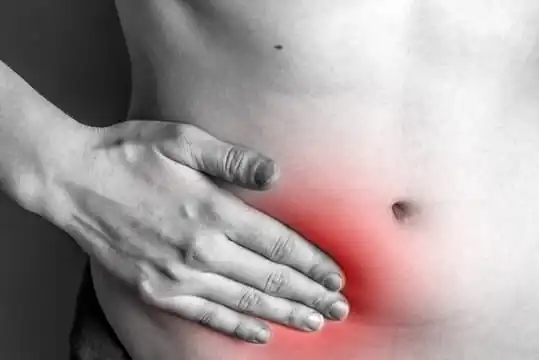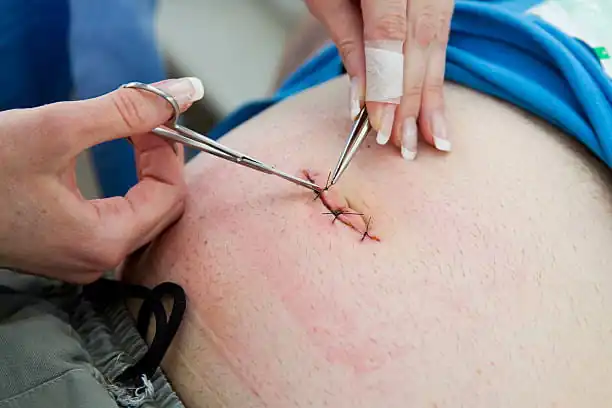Hernia Surgery
What is Hernia Surgery?
Hernia repair surgery is an operation to repair defects in the abdominal wall layers. There are two types of surgical approaches in hernia repair surgery: "traditional" open surgery or minimally invasive surgery (laparoscopic/key-hole). The laparoscopic approach has a similar rate of recurrence (re-occurrence) of the hernia compared to the open approach. However, the laparoscopic approach results in a quicker return to work and normal activities and, in some patients, less pain.
Dr. Michael Chu will discuss the advantages and disadvantages of the different approaches during his consultation with you to enable you to select the best surgical approach for your hernia. He will ensure you obtain the best outcome from your hernia surgery.

Indications for Hernia Surgery
The presence of a hernia does not always require surgery, as it can be asymptomatic. However, a hernia does not improve or disappear over time and generally worsens in time with enlargement of the hernia or worsening symptoms. In certain cases, patients may require emergency surgery if the hernia is irreducible or strangulated.
How is a Hernia Repair Surgery performed?
Open Hernia Repair
This is the “traditional” method for repairing hernias, including groin hernias. Occasionally, it may be recommended instead of a laparoscopic repair.
Reasons for this may include:
- Hernia recurrence following laparoscopic repair
- Patients at high risk for general anaesthesia, as laparoscopic repair requires general anaesthesia. For these patients, open repair would be recommended, as it can be done under local anaesthetic.
- Significant previous abdominal surgeries
- If the patient is very overweight
Open groin hernia repair is performed with a longer (7-10 cm) incision in the groin. All open hernia repair involves dissecting out the hernia sac and content before reducing the hernia back into the abdominal cavity. The abdominal wall defect is then reinforced with mesh (secured in place with sutures), or in some cases where the abdominal wall defect is small, the defect will be primarily closed with sutures.
If mesh is required, the mesh will be placed in a “sublay” manner under the abdominal wall layers but outside of the abdominal cavity. The placement of the mesh in this layer has the advantage of keeping the mesh out of the abdominal cavity, away from abdominal contents This approach is less prone to seroma formation (fluid collection) and provides a stronger repair. In some cases, it will not be possible to keep the mesh away from the abdominal contents. In these situations, an absorbable mesh or a mesh with a barrier that prevents adhesion will be utilised.
Laparoscopic Hernia Repair
In recent years, laparoscopic groin hernia repair has been the preferred approach to surgically repairing a groin hernia.
Indications for laparoscopic groin hernia repair include:
- Recurrence of groin hernia from previous open groin hernia repair
- Bilateral groin hernias (both sides)
A 10 mm incision is made just below the umbilicus, and two further 5 mm incisions are made in the midline between the umbilicus and pubic bone. Carbon dioxide gas is used to insufflate the abdominal wall to lift the abdominal wall away from the abdominal organs. A laparoscope (telescope) is inserted through the 10mm port, allowing visualisation of the hernia and surrounding area. Laparoscopic instruments are inserted into the 5 mm incisions to dissect and reduce the hernia.
A piece of surgical mesh (soft and flexible) is placed beneath the abdominal wall and outside the abdominal cavity to reinforce the abdominal wall where the defect/weakness was. This prevents the hernia from “popping” out through the abdominal wall defect. The mesh is then held in place with tacks onto the pubic bone. No tacks are placed on the abdominal muscles, as this has been associated with an increased incidence of post-operative chronic pain. The instruments and laparoscope are removed, and the carbon dioxide is released before closing the incisions with dissolvable sutures.
Dr. Michael Chu will discuss the surgical approach and usage of mesh (and type) with you to ensure you select the best surgical approach for your hernia.
Pre-Operative Assessment
Initial Assessment
Initial assessment will involve a thorough clinical examination, in particular, to confirm the diagnosis of a hernia. In certain cases, imaging (usually with a CT scan) may be required to assess the anatomy of the hernia prior to proceeding with an operation. The results of the imaging will be discussed with you, and treatment options will be outlined.
Anaesthetic Assessment
Once a decision has been made to proceed with surgery, you will be requested to fill out an anaesthetic questionnaire. This will be reviewed by the anaesthetist who will be responsible for your care, and you may be required to see the anaesthetist in person or sent for additional tests. Once you have completed the anaesthetic review, the date of surgery will be confirmed with you.
Risks of Surgery
There are risks with any surgery, and they can be divided into “General” or “Procedure”-specific risks. The risk of a serious complication is ~0.1% (1 in 1000 patients).
General Risks
- Wound infection
- Bleeding
- Venous thromboembolism (VTE), e.g., deep vein thrombosis (DVT) or pulmonary embolism (PE)
- These complications are uncommon following hernia repair.
Procedure-specific Risks from Hernia Repair
- Seroma formation
In a small number of patients, fluid can build up around the mesh or the “dead space” where the hernia used to be—this is termed a seroma. Seroma formation is more common in open hernia surgery, especially in large incisional hernia repair. Generally, this is self-limiting but may require aspiration using a small needle under local anaesthetic.
- Significant bleeding
This may be due to damage to the large blood vessels in the groin and can occur in either open or laparoscopic surgery. The incidence is around 1 in 500 patients. A blood transfusion may be required, and an emergency abdominal re-operation will be required.
- Injury to surrounding bowel structures
There is a 1 in 300 incidence of injury to the surrounding bowel structures or bladder. In laparoscopic surgery, this can be from the introduction of the laparoscope or instruments into the abdomen, or from dissection of the hernia content. Similarly, in open surgery, the hernia content may be injured during the dissection. If there was an injury to the abdominal organs, a re-operation to repair the injuries will be needed.
- Conversion to Open Surgery
In some cases, open surgery is needed to complete the groin hernia repair, which occurs in around 1-2% of cases.
Risk factors that may lead to conversion to open surgery include:
- Patients who are overweight.
- Dense adhesion (scar tissue) precluding safe laparoscopic surgery, particularly with previous prostate surgery.
- Significant bleeding during surgery.
This involves a separate, longer incision in the groin. The decision to convert to open is to ensure the operation can be completed safely for the patient.
- Scrotal swelling
In male patients following groin hernia surgery, the scrotum may swell due to the surgery or in some cases, from bleeding from the groin that tracks into the scrotum. This generally resolves without further intervention but occasionally, the swelling may need to be drained with a needle under ultrasound guidance.
- Inability to pass urine post-operatively
This is more common in older male patients undergoing groin hernia surgery and is usually caused by a bladder spasm or side effect of the opiate analgesia. It is a temporary issue but may require the insertion of a catheter (plastic tube) into the bladder to drain the urine. If you have issues passing urine before the surgery, please inform Dr. Michael Chu.
- Injury to spermatic cord structures
This is for males undergoing groin hernia surgery and involves injury to the vas deferens (the tube carrying sperm from the testicle to the prostate). This may reduce fertility in 0.5% (1 in 200 patients) of patients. Rarely, the testicular artery (the artery that supplies the testicle) may be injured and this may cause testicular ischemia, with subsequent shrinking (atrophy) of the testicle.
- Persistent groin pain
Occasionally, the nerves in the groin may be cut, involved in a suture or scar tissue. Chronic groin pain (can be mild or severe) is defined as persistent (> 3 months) pain and burning sensation in the groin in ~2% (1 in 50) of patients. The incidence is lower in laparoscopic groin hernia compared to open surgery. If this occurs, injections of local anaesthetic to the area or long-term medications may be required. In Dr. Michael Chu’s experience, this complication is rare.
- Recurrence of the hernia
The recurrence rate for groin hernias is ~2% (1 in 50 patients) and is the same for laparoscopic and open groin hernia repair. For other hernias, this is dependent on the size of the hernia and the integrity of the abdominal wall tissues.
Other risk factors for the recurrence of a hernia are:
- Overweight
- Smoking
- Poor nutrition
- Steroid use
Further surgery will be required to repair the recurrent hernia. In groin hernias, the approach will be opposite to the initial surgical approach. For example, open groin hernia surgery will be recommended if a previous laparoscopic groin hernia surgery has already been performed.
Post-Operative Management
Most patients can be admitted on the day of the operation and discharged later that day. This can be true for both open and laparoscopic hernia repairs. However, older patients with medical co-morbidity (heart and lungs) or urinary issues may need to stay overnight. Patients who have large or complex abdominal wall hernias may require additional nights in the hospital, depending on their comfort level.

During your hospital stay, Dr. Michael Chu will review you twice a day. The ward staff is very experienced in caring for patients following hernia surgery and will care for you.
Post-Discharge Management
When should I seek medical input?
If you or your family have any concerns, please contact Dr Michael Chu directly in his room or the hospital. If it is a medical emergency, please dial 111 for an ambulance to take you to the nearest acute hospital.
How does my General Practitioner (GP) know about my surgery?
Dr. Michael Chu will send a letter summarising your hospital stay and a copy of your operation note to keep your GP up to date with your status. It is advisable that you make an appointment with your GP a few days after your discharge so they can physically assess your clinical status.
Dr. Michael Chu is happy to be contacted by your GP if they have any questions or concerns.
Common side-effects of surgery & solutions
- Pain or discomfort
After an operation, a degree of discomfort is expected and usually improves over the first two weeks. In some patients, the discomfort may last for a few weeks. The prescribed analgesia aims to ensure that the discomfort is manageable so that you can continue to improve physically. However, if the pain is worsening or you have any concerns about its duration, please contact your GP or Dr Michael Chu.
- Bruising
There is usually bruising around the incision, and it may appear within 24-48 hours after surgery. If you feel that the bruising is worsening, becoming painful, or there is discharge of pus from the wound, please contact Dr. Michael Chu.
- Constipation
This is a common occurrence following any abdominal surgery. It is usually related to the opioids during general anaesthetic or those given post-operatively for analgesia. There are a few laxatives that can be obtained over the counter at the pharmacy or by prescription. Similarly, natural dietary supplements such as kiwi fruit are also quite effective. Importantly, please drink plenty of fluid.
Frequently Asked Questions about Hernia Surgery
Why choose laparoscopic groin hernia repair?
It holds true that open groin hernia repair is the gold standard treatment for groin hernias. However, laparoscopic groin hernia repair in the hands of trained surgeons has also been shown to have excellent outcomes comparable to an open groin hernia repair.
The key advantages of laparoscopic groin hernia repair include:
- Decreased post-operative pain
- Lower rates of post-operative chronic groin pain
- Faster recovery to normal activity
- Reduced wound size or scarring
Disadvantages of laparoscopic groin hernia repair include:
- Increased cost due to the cost of laparoscopic instruments
- Steeper learning curve for surgeons
- Potentially longer operating time
What is the recovery period?
For laparoscopic groin hernia repair, the recovery period is at least 3-4 days before returning to normal activity. For an open hernia repair, the recovery period may be 2-3 weeks.
How soon can I drive after hernia surgery?
It is usually recommended that you do not drive for 48-72 hours after laparoscopic groin hernia surgery. For open hernia surgery, the recommendation would be 4-5 days before driving. When you get home and feel ready to drive, sit in the car seat and ensure you can perform a full emergency stop/brake before you start driving. It is also advisable that you should be able to have the strength to control the car and respond quickly before you start driving.
Importantly, please check with your insurance policy and company to ensure that driving post-operatively does not invalidate your policy.
What do I need to do to prepare for surgery?
Once a proposed date for surgery has been set, you will need to follow these instructions:
- Specific instructions will be given on where and when to present for surgery
- Specific instructions will be given on when to stop drinking and eating. It is important that you follow these instructions as it will pose an anaesthetic risk, and we may have to cancel/delay your surgery.
- You do not need to shave before coming into hospital
- You will be advised on what normal medications to take on the day of surgery, but only take them with a small amount of water.
- If you are on any blood thinners that affect clotting, please inform Dr. Michael Chu during your initial consultation, as they may need to be stopped well in advance of the day of surgery. If you are unsure about the medications, please ask Dr. Michael Chu and the anaesthetist.
What is the follow-up process for me?
A follow-up will be arranged for you after you have been discharged from the hospital. Dr. Michael Chu's PA will get in contact with you, and the follow-up is usually 2-3 weeks after leaving the hospital.
At the follow-up consultation, Dr Michael Chu will go through with you:
- How you are recovering
- Operative findings
- Any concerns you may have
If you have any questions or concerns during your post-operative period, please contact Dr. Michael Chu at +64 27 216 7288.
Mesh-Related Questions
Is mesh safe?
In recent times, there has been a lot of controversy in the media about the use of surgical mesh and that it should be banned from all types of surgery. The controversy lies within the use of surgical mesh in transvaginal repair of vaginal prolapse with reports of infection, chronic pain, and erosion. However, this procedure has been used to portray and link the adverse outcome of using mesh to other surgical procedures as well. Understandably, this has led to widespread patient anxiety and concerns throughout New Zealand.
In General Surgery, the use of mesh to repair hernias of the abdominal wall or groin has been studied extensively worldwide. It is considered the “Gold Standard” procedure for groin hernia repairs —the tension-free mesh repair of an inguinal hernia. For abdominal wall hernia defects larger than 2 cm, mesh is also used and placed in the sub-lay position. In these cases, the recurrence rate of a repair without mesh is unacceptably high compared to a mesh repair.
The General Surgical training programme includes the use of surgical mesh in various types of operations. As a result, New Zealand General Surgeons are well trained with extensive experience in the use of mesh for hernia repair.
Read the position statement on surgical mesh from the New Zealand Association of General Surgeons released in 2017.
What if I choose not to have mesh?
For groin hernias, there are alternative operative techniques described that do not utilise mesh. These techniques can only be performed open and not laparoscopically. The only technique that has been shown to have a comparable outcome (recurrence rate) to a mesh repair is the Shouldice operation, but similar results have not been able to be replicated outside of Shouldice Hospital.
For abdominal wall hernias, using mesh is dependent on the size of the abdominal wall defect. If it is larger than 2-3 cm, the failure rate of primary suture repair is significantly high and would be an unacceptable risk.
Dr. Michael Chu will have an in-depth consultation with you before proceeding with surgery so that you can have the peace of mind that you have chosen the right surgical approach for your hernia.
